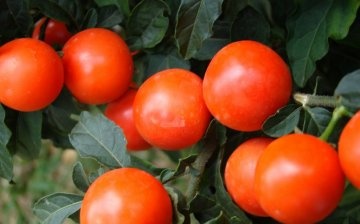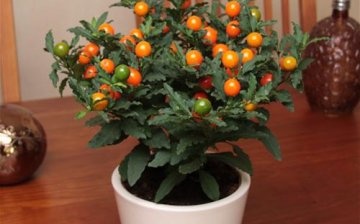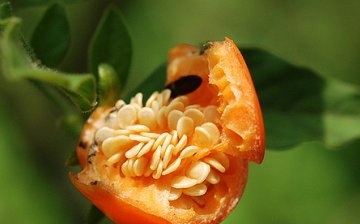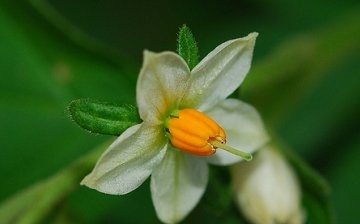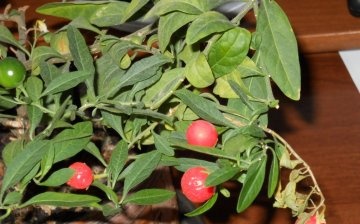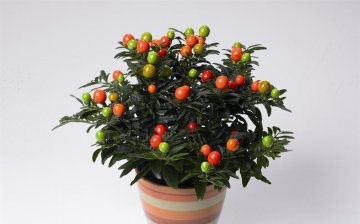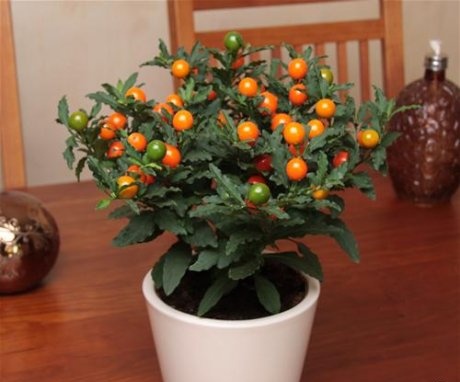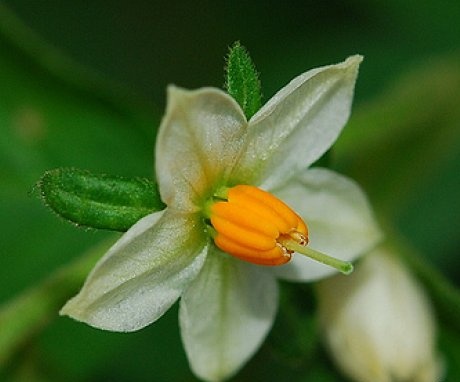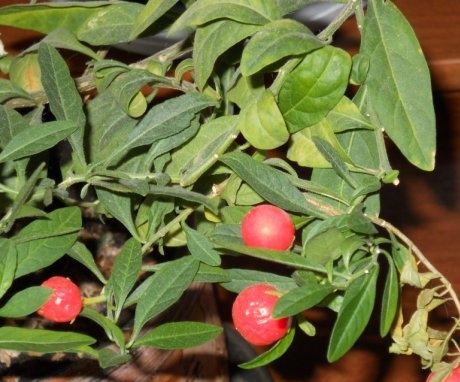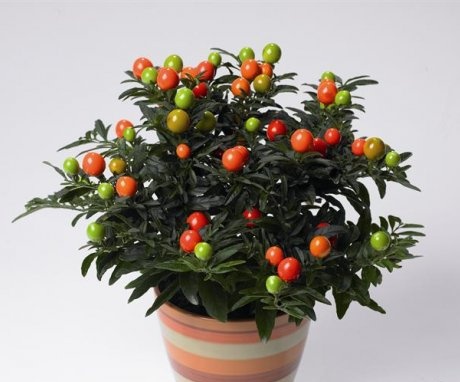Indoor flower nightshade: planting, care and properties
Nightshade (Solanum) is a shrub from the Solanaceae family, the genus of which has about 1,700 species. The homeland of nightshade is considered to be South American countries with a tropical climate. In the wild, you can find annual and perennial herbaceous plants in the form of shrubs and trees, the stems of which can creep or stand upright, and the fruits are predominantly poisonous. Among the nightshades, there are also edible species such as potatoes, tomatoes and eggplants.
For cultivation at home, a small part of the Solanaceae is suitable - the most common are edged, peppery and dark brown nightshade, the fruits of which are compared with small tomatoes, cherries or Mexican peppers. These Latin American machos are able to delight their owners with a decorative look all year round. However, for this you need to know some tricks of caring for this plant.
Content
- What is this nightshade plant
- What conditions are optimal for nightshade
- Reproduction and planting of a plant
- Proper care of indoor nightshade
- Growing problems
- Poisonousness and medicinal properties of a flower
What is this nightshade plant
Indoor nightshade is popularly called winter cherry or coral bush. Quite often, in home breeding, you can find pepper and pseudo-pepper nightshade. They differ from each other, albeit slightly. The main difference lies in the shoots of the bush. False nightshade - the owner of smooth hairless shoots and leaves, and in pepper - they are covered with a light gray fluff. They also differ in their properties.
Pepper nightshade fruits are used in folk medicine for the treatment of sore throats and wound healing, and the pseudo-pepper representative is a poisonous killer.
Therefore, if the plant decorates the interior of the room, then it should be located at a considerable distance from the floor so that children's hands do not get to the mouth-watering berries.
The nightshade reaches a height of half a meter, is very decorative and often becomes an ornament on New Year's holidays, when a fluffy green bush is strewn with bright multi-colored berries, hence the name - winter cherry. Small berries appear after flowering and, as they ripen, change color from green to rich burgundy. At the same time, on one bush, the ripening of fruits is uneven, therefore cherries, tomatoes or peppers of various shades, which increases the decorative effect of the plant.
What conditions are optimal for nightshade
It should be remembered that decorative nightshade is a plant from the tropics, so the conditions of detention should be as close as possible to natural ones. The plant requires constant spraying and maintaining an optimal temperature, which is lowered for the winter.
Also, the flower is quite photophilous, but categorically cannot stand direct sunlight.
If the flower doesn't like something, then it will notify about it:
- dropping leaves, which means that the plant lacks light
- poor flowering and small fruits - about insufficient heat
- curling leaves - about an excess of sunlight
- drooping sluggish leaves - about poor watering and a hot place
- shrunken berries - about a lack of moisture in the soil
- dull leaves - about lack of nutrition
The humidity level should always be high and not fall below 60%.
Reproduction and planting of a plant
Indoor plant propagation can be done seeds and cuttings:
- When planting seeds, leafy soil is most suitable, on the surface of which the seed is laid out at a distance of 2 cm from each other and sprinkled with sand. The container is placed in a warm place for germination, creating greenhouse conditions with a film cover. The seeds will sprout within 10 days. The borings in the first stages grow very intensively and therefore they need dive, and this procedure is carried out twice. This is necessary to give the future bush a compact spherical shape. After the second pick, the plant can be planted in the ground.
- The propagation process with cuttings is a faster process. Cut twigs are used as cuttings. It is easiest to root the cuttings in a sand-peat mixture, and when a sufficient number of roots are formed, transplant the plant into a suitable soil. With proper care, flowering and fruiting is possible in young flowers.
The development of nightshade and the size of its berries depend on the breeding method. When propagated by seeds, the plant grows longer, but stronger and bears fruit actively. When grafting nightshade takes time to adapt and the fruits of the former are small, and flowering is poor.
The optimal soil for nightshade is a mixture of peat and clay soil in a ratio of 1: 3 with the addition of a small amount of sand. At the bottom of the planting container, it is imperative to place expanded clay or crushed stone drainage; small brick fragments are also suitable.
Proper care of indoor nightshade
Conditionally, caring for decorative nightshade can be divided into three stages:
- Spring - the stage of planting and transplanting a plant.
- Summer - the growing season and flowering.
- Autumn-winter is the time of fruiting and subsequent dormancy.
The basic principles of care are to provide the necessary conditions:
- Lighting. It is possible to achieve a bright decorative effect of a flower only by providing bright, but diffused light, which the plant needs throughout the year. For this, the east and west sides of the room are well suited. The south side will come in handy during the winter. If there is not enough light, the development of nightshade will be weak, and flowering and fruiting will be poor.
- Humidity and temperature conditions. The optimum room temperature for the full development of the plant is considered to be 18-25 degrees in spring and summer, and in winter it should be reduced to 12-15 degrees. Otherwise, the tropical friend will drop all the berries and leaves. You should also worry about protecting the nightshade from drafts. Humidity should always be high. To ensure this condition, the flower is systematically sprayed... It is not superfluous to place the flowerpot with the plant in a shallow dish with moistened stony material so that there is no contact with water. With increased dryness of the air, fruiting occurs later and it is weaker.
- Watering... In the spring-summer period, when the plant is intensively developing and blooming, it should be watered often and abundantly. Irrigation is carried out immediately after the topsoil dries up, which occurs quickly, since nightshade sweats intensively, evaporating moisture through the foliage. In winter, watering should be reduced.
- Top dressing... For fruiting, nightshade needs a lot of strength that can provide top dressing. You can apply a complex liquid fertilizer to house flowers that are in bloom. It should be applied during the growing season and during fruit formation. Top dressing is carried out once every two weeks, and when the fruits have already set, that is, in winter, the interval between dressings should be reduced to once a month, using half of the fertilizer rate.
- Pruning... Nightshade is pruned annually. At the end of winter or at the beginning of spring, all the branches of the shrub are shortened by a third. It is customary to perform this procedure after the fruits are fully ripe and when the leaves turn yellow. And in the fall, it is recommended to pinch the plant, but only those shoots where there are no buds and fruit ovaries. This will provide better bushiness.
- Transfer... After pruning, the ornamental shrub must be transplanted into a renewed soil rich in microelements. In this case, the pot should be slightly larger than before. But in some cases, a transplant may not be required, because the nightshade flower quickly loses its decorative effect and it is often easier to grow a new plant.
Growing problems
Although the nightshade plant is unpretentious, there are some difficulties in keeping it:
- Little or no fruiting. Insufficient pollination in the flowering period leads to this. If the plant is not taken out into the open air, it is recommended to artificially pollinate it. For these purposes, use a soft brush, through which pollen should be transferred from one flower to another. To consolidate the effect, the procedure is carried out several times.
- Nightshade drops leaves and berries. Drafts, sudden temperature changes, or heat may be the cause. To eliminate these troubles, you just need to find a more suitable place for the nightshade.
- Pests... Insects can also cause inconvenience to the plant: whiteflies, aphid and spider mites. At risk are those plants that are kept in dry air. When the first signs of an insect attack are found, the plant should be treated with appropriate chemicals or folk remedies should be used (if the damage is not severe).
Poisonousness and medicinal properties of a flower
Some varieties of indoor nightshade are poisonous. Even a small concentration of toxic substances contained in the fruit can lead to poisoning. This usually results in an upset stomach, but at high concentrations, it can cause intoxication of the whole body, which may require medical intervention.
Along with this, nightshade also has medicinal properties and can act as a home healer. The fruits and leaves of the plant are used for the prevention and treatment of many diseases, because they contain vitamins, carotenoids, alkaloids, pectins and saponic acids. These substances effectively fight bronchitis, sore throat and whooping cough, and are also able to heal wounds well. In addition, infusions made from nightshade have anthelmintic and diuretic effects.
However, due to the toxicity of the plant, nightshade medicines should be used very carefully, after consulting with a specialist.
Flower nightshade easy enough to grow at home. An unpretentious and ornamental plant will require a little effort and adherence to simple rules. And due to its decorativeness, nightshade is able to decorate and diversify any interior and give a festive mood. The flower will gratefully respond to care with flowering and fruiting, giving the plant originality. And the flower can also heal domestic inhabitants from unpleasant diseases. However, you should keep the plant away from babies to avoid unpleasant consequences.
More information can be found in the video:




